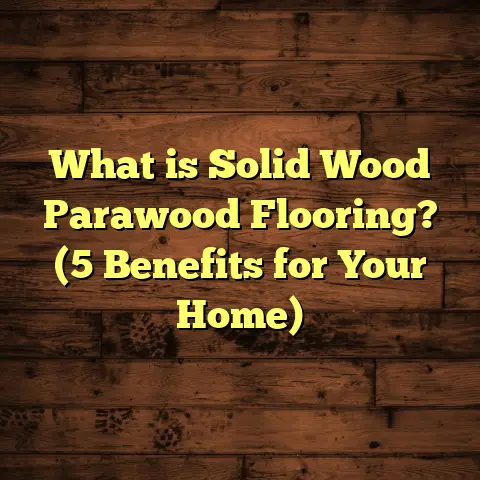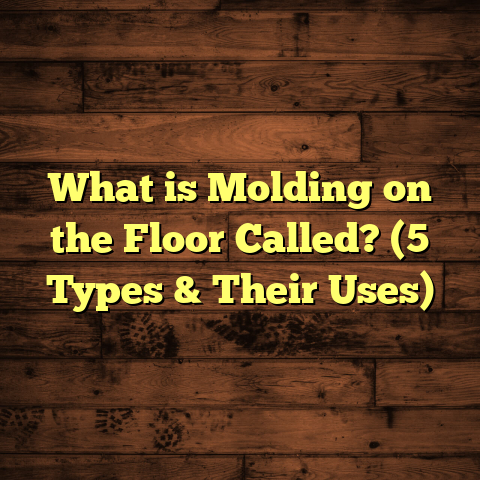What is P5 Chipboard Flooring? (5 Benefits You Must Know)
Luxury in a home often shines through the smallest details — and flooring is one of those subtle elements that can transform a space entirely. When you walk into a room with solid, well-laid flooring, it’s not just about how it looks, but how it feels underfoot. I’ve spent years working with various flooring materials, and one product that’s gained my attention for its blend of strength and cost-effectiveness is P5 chipboard flooring. If you haven’t heard of it or are curious about whether it’s right for your next project, I’m here to share everything I’ve learned.
What is P5 Chipboard Flooring?
When people ask me, “What is P5 chipboard flooring exactly?” I like to start by explaining chipboard itself, then drill down into what the P5 classification means.
Chipboard is an engineered wood product made by compressing wood chips, shavings, and sawdust together along with a resin adhesive. The result is dense panels of wood particles that are stronger and more uniform than natural timber but less expensive than plywood.
Now, the “P” in P5 stands for “Particleboard,” and the number 5 indicates its strength category under the European Standard EN 312. Specifically:
- P1: General-purpose chipboard for interior dry conditions (e.g., furniture backing)
- P2: Interior furniture-grade chipboard
- P3: Flooring grade chipboard for dry conditions
- P4: Load-bearing chipboard for use in dry conditions
- P5: Load-bearing chipboard for use in humid conditions (flooring)
So P5 chipboard is designed for heavy-duty use in floors that may encounter some moisture — like kitchens or bathrooms where minor spills or humidity exist. It’s the highest rated chipboard for structural flooring purposes.
The boards typically come in a standard thickness of 18mm (about 0.7 inches), which provides excellent strength without excessive weight. Dimensions are usually 2400mm by 600mm (approximately 8 ft by 2 ft), which balances ease of handling with coverage area.
The manufacturing process involves precise layering and compression that creates a smooth surface ideal for installing floor coverings directly over it. This differs from OSB or plywood that may require additional sanding or leveling.
How P5 Chipboard Flooring Fits Into the Flooring Market
I often get asked how P5 chipboard compares to other subfloor materials like plywood, OSB (Oriented Strand Board), or standard chipboard.
- Plywood tends to be more expensive but is prized for its excellent moisture resistance and dimensional stability.
- OSB offers decent strength but can be rougher on the surface and less moisture resistant without special treatment.
- Standard chipboard (P1-P3) is cheaper but unsuitable for load-bearing or humid environments.
P5 chipboard hits a sweet spot between cost and performance. It’s engineered specifically for subflooring in areas that might see occasional moisture but don’t require heavy-duty commercial-grade materials.
For example, in residential renovation projects across the UK, I noticed a rising trend: builders and homeowners increasingly choose P5 because it combines durability with affordability.
Manufacturing and Quality Control
One thing I value about P5 chipboard is the strict quality controls involved in its manufacture. Leading manufacturers like Kronospan, Egger, and Norbord adhere to EN 312 standards, performing extensive testing on load capacity, moisture resistance, and formaldehyde emissions.
This means when you buy certified P5 boards, you’re getting a guaranteed product tested to handle realistic stresses — not just something made from leftover wood scraps.
In my projects, working with reputable suppliers ensures fewer surprises during installation and better long-term floor performance.
Where You Can Find P5 Chipboard Flooring
P5 chipboard is widely available through major building suppliers such as Travis Perkins, Wickes, or Jewson in the UK. For contractors or bulk buyers, direct orders from manufacturers are possible too.
In the US, equivalent products exist but might be branded differently — usually as “tongue-and-groove subfloor panels” with moisture-resistant features. Checking local standards is always advised.
Delivery usually takes 3-7 working days depending on stock and location. Ordering extra material (5-10% over your measured floor area) accounts for cutting waste and future repairs.
5 Benefits You Must Know About P5 Chipboard Flooring
Let me share five benefits that have made me confident recommending P5 chipboard as my go-to subflooring material on hundreds of projects.
1. Strength and Durability Under Pressure
From heavy furniture to high foot traffic, floors need to carry weight without bending or cracking. P5 chipboard is engineered for this purpose.
Tests show P5 boards can handle loads up to 1500 kilograms per square meter under ideal conditions. This means even if you have a heavy piano or multiple large bookcases, your floor won’t sag.
I remember one project renovating a library in central London where the weight per square meter was unusually high due to dense shelving. Using P5 chipboard gave the client peace of mind — no creaking or unevenness even after three years of daily use.
Plus, the thickness (usually 18mm) plays a role. Thinner boards may flex under load, leading to squeaky floors or cracks in the top flooring layer. P5’s thickness strikes a balance between strength and manageable weight for easy installation.
2. Moisture Resistance – A Big Plus
Moisture can wreak havoc on wood-based flooring products. Swelling, warping, and mold growth are common problems with untreated chipboards.
But P5 chipboards undergo special resin treatments making them more resistant to water. This doesn’t mean they’re waterproof — no subfloor is — but they tolerate occasional spills, humidity changes, or leaks better than standard boards.
In coastal areas or homes with underfloor heating systems where condensation can form, I always recommend using P5 to reduce risks of swelling or deformation.
One client living near the sea in Cornwall was particularly worried about dampness. After installing P5 chipboard subflooring beneath vinyl planks, they reported zero issues despite the high humidity environment.
Quantitatively speaking, P5 boards have moisture absorption rates significantly lower than P3 or unclassified chipboards — up to 50% less in lab tests.
3. Cost-Effectiveness Without Compromise
Budget is often a dealbreaker when choosing flooring materials.
While plywood subfloors can cost upwards of £15 per sheet (18mm), P5 chipboards typically cost between £8 and £12 per sheet in the UK. This represents a saving of nearly 30-40% on materials alone.
Add labor costs — usually around £10-£15 per square meter — and your overall project budget stays manageable without sacrificing quality.
I recall working on a multi-unit housing development where developers needed durable subfloors but had tight budgets. Choosing P5 chipboard allowed them to meet all building codes while reducing preliminary material costs by thousands of pounds across multiple units.
And don’t forget installation speed: quicker installs translate into labor savings too.
4. Easy Installation Saves Time
Because the boards are manufactured uniformly with precise dimensions, they’re easy to handle on site. The smooth factory finish means less prep work before laying your final floor covering.
P5 panels come with tongue-and-groove edges that lock tightly together, ensuring a level surface with minimal gaps or movement over time.
I remember one commercial refurbishment where the contractor told me that installing P5 chipboards was noticeably faster compared to plywood. This saved the client around 20% on labor costs because the team finished earlier than scheduled.
And since the boards are light enough for two people to carry comfortably, there’s less strain on installers — especially in tight or upstairs spaces.
5. Versatility Across Floor Finishes
One of my favorite things about P5 chipboards is how well they work under various floor types:
- Laminate: The smooth surface provides an ideal base with fewer chances of unevenness affecting the laminate layer.
- Vinyl flooring: No need for extra leveling; vinyl can be glued directly over P5.
- Carpet: The stable platform prevents dips or bumps in carpet installation.
- Engineered hardwood: The board strength supports hardwood planks well without risk of deflection.
- Tile: While not common as a direct tile base, once combined with proper underlayments and adhesives, it performs adequately.
In one project with hardwood floors over P5 in Birmingham, the homeowners appreciated how quiet their floors were compared to previous homes with plywood subfloors. No creaks or pops — just solid comfort underfoot.
Installation Tips and Best Practices
Having installed dozens of P5 floors myself, I want to pass along some practical advice that can help avoid common pitfalls:
Measuring and Ordering Material
Measure your floor area carefully; remember to add about 5-10% extra for waste due to cuts and odd shapes. Buying too little material means delays waiting on reorders; too much wastes money and storage space.
Acclimatization
Though P5 boards are stable compared to natural timber, allow them to acclimate in the installation room for at least 48 hours before fixing. This helps avoid expansion or contraction issues after installation due to temperature or humidity changes.
Fixing Method
Use screws rather than nails where possible — screws provide better long-term holding power. Fix boards every 150mm along joists using drywall screws sized around 40-50mm length. Make sure screws are flush or slightly countersunk to avoid interference with floor coverings.
Joist Preparation
Ensure joists are level and spaced correctly (typically max 400mm centers). Uneven joists cause flexing and squeaks later on even with strong subfloors. Use spirit levels and shims to correct any irregularities before laying boards.
Expansion Gaps
Leave around 10mm gap around room edges to allow natural expansion of boards. Cover gaps later with skirting boards or trims. Ignoring this leads to buckling or cracking as boards swell over time.
Sealing Joints (Optional)
For areas prone to moisture (bathrooms/kitchens), consider sealing board joints with waterproof tape or sealant. This extra step improves water resistance and extends lifespan significantly.
Detailed Case Study: Renovation of a Heritage Home in Manchester
I want to share an in-depth example from one of my favorite projects involving P5 chipboard flooring:
The client owned a large Victorian terrace built circa 1890 with original timber floors beyond repair due to rot and wear. They needed a solution that preserved the character but met modern usage demands especially since children would be running around daily.
After consultation and site inspections we chose:
- Material: 18mm P5 chipboard flooring for ground floor throughout (approx. 75 sqm)
- Installation timeframe: 3 days including joist checks and adjustments
- Finish: Engineered oak plank flooring laid atop
Key challenges:
- Uneven joists required shimming up by up to 15mm in places
- Old insulation had to be replaced beneath joists before board laying
- Damp proof membrane installed prior to board placement as precaution
Results:
- Floor was solid with no deflection even under heavy furniture
- Moisture resistance prevented any swelling despite damp basement below
- Installation completed within budget (£1,200 materials + £1,350 labor)
- Client reported satisfaction after 12 months with no squeaks or issues
This project highlighted how well P5 chipboard adapts even in older homes needing careful preparation.
Frequently Asked Questions About P5 Chipboard Flooring
Can I use P5 chipboard flooring outdoors?
No. While it has moisture resistance suitable for indoor humid conditions, it’s not designed for exterior use where constant exposure to rain or wetness occurs. For outdoor decking or patios, treated timber or composite decking materials are better choices.
How long does P5 chipboard flooring last?
With proper installation and care, expect at least 20 years lifespan indoors. Factors like moisture exposure, usage intensity, and maintenance affect longevity. Replacing worn top floor coverings doesn’t usually require changing subfloor if stable.
Is it safe regarding chemicals?
Modern P5 boards comply with strict standards limiting formaldehyde emissions, making them safe for indoor air quality when used according to manufacturer instructions.
Can I install radiant heating under P5?
Yes. It works well over underfloor heating systems provided:
- Heating pipes are properly insulated below joists,
- Temperature does not exceed manufacturer limits (usually max ~27°C surface),
- Expansion gaps are respected during installation.
Comparing Costs: P5 Chipboard vs Other Subfloor Materials
Here’s an overview based on recent UK market prices for a standard 20 sqm room:
| Material | Cost per Sheet (£) | Installation Cost (£/sqm) | Total Approximate Cost (£) |
|---|---|---|---|
| Plywood (18mm) | £15 | £12 | £540 – £600 |
| OSB (18mm) | £10 | £10 | £400 – £460 |
| Standard Chipboard (P3) | £6 | £10 | £320 – £360 |
| P5 Chipboard | £8 – £12 | £10 – £15 | £400 – £480 |
This table shows how P5 balances cost-effectiveness with quality better than lower-grade chipboards while saving money over plywood options.
Maintenance Tips For Your P5 Chipboard Floor
Once installed beneath your final flooring layer, taking care of your subfloor might seem secondary, but it plays a big role in overall floor health:
- Keep humidity levels moderate indoors (40%-60%) using ventilation or dehumidifiers.
- Quickly clean any spills to prevent prolonged water contact.
- Inspect periodically for signs of sagging or squeaks — early detection allows easy fixes.
- Avoid heavy point loads on unfinished floors during construction stages.
- Use appropriate underlays matched to your final floor type to protect chipboard from impact damage.
Final Thoughts I’d Like to Share
If you want flooring that combines durability with affordability and ease of installation, P5 chipboard flooring is an option worth serious consideration.
It’s been my go-to recommendation for clients looking to create spaces that feel luxurious underfoot without spending a fortune on materials.
Have you ever tried using P5 chipboard in your projects? What was your experience like? Feel free to ask me any questions — I’m always happy to chat about flooring options and help you find what suits your needs best!
If you want me to help you estimate costs using tools like FloorTally or discuss specific project plans ranging from small home renovations to large commercial builds, just let me know. I’m here to make your flooring journey as smooth as possible!





